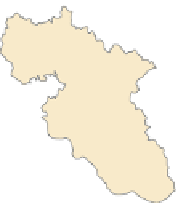Geography Reference
In-Depth Information
Fig. 6.15
Study area
113°E
114°E
115°E
116°E
N
32° N
31° N
Xiaogan
31° N
Hu anggang
Wu h a n
Tianmen
Ezhou
Qianjiang
Xiaotao
30° N
Huangshi
30° N
Xiangning
(km)
29° N
0
30
60
120
29° N
113°E
114°E
115°E
116°E
Climate data includes annual precipitation and annual average temperature data.
Based on China weather site observation data, spline interpolation arithmetic method
is employed to interpolate meteorological site's observation data to get grid form of
annual precipitation and annual average temperature surface in research region.
6.3.2 Methodology
6.3.2.1 Research Framework
The basic idea of scenario analysis on the impacts of urban land expansion on
climate change is performed by Fig.
6.16
. Based on setting urban land expansion
scenarios in Wuhan Metropolitan, the Partitioned and Asynchronous Cellular
Automata Model is employed to carry out the scenarios simulation of urban land
use expansion in Wuhan Metropolitan, so as to get spatiotemporal pattern of urban
land expansion. By converting urban land expansion simulation results to under-
lying surface data to be input into WRF model, regional climate change under
different scenarios in Wuhan Metropolitan can be carried out. By comparing
analysis on climate change effects of urban land expansion under different sce-
narios, it is helpful to get reasonable urban land expansion pattern for mitigation
climate change in Wuhan Metropolitan.
Urban land Expansion Scenario
Urban land expansion pattern scenarios of Wuhan Metropolitan are set up first. In
this part, three urbanization pattern scenarios are setup. They are baseline scenario,































